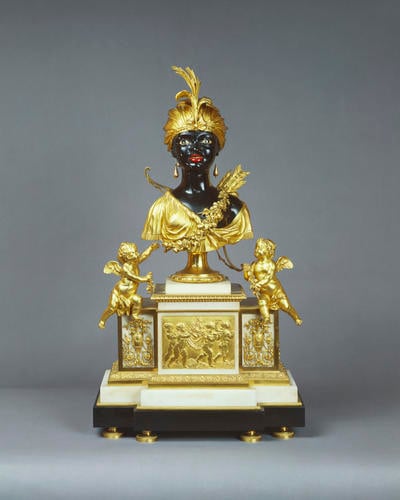Mantel Clock 1790
Gilt and lacquered bronze, marble base | 75.5 x 42.7 x 23.8 cm (whole object) | RCIN 30390
-
A combined gilt and lacquered bronze clock and musical box in the form of the bust of an African woman wearing a turban and aigrette and a draped tunic with a garland of flowers and foliage. Attached to her back is a bow and quiver of arrows. She is flanked by two gilt bronze putti.. The clock shows the time with the hours in Roman numerals in the left eye and the minutes in Arabic numerals in the right eye. The pupils slide back to reveal the time at ten minutes to the hour, and close at two minutes past the hour. They can be reopened by pulling the right earring.
The music box in the base (which contains a sixteen-pipe organ) is activated by pulling the right earring. Eight tunes are played, four popular French songs have been identified so far:
1. Chorus Que d'attraits from act one of Christoph Willibald Gluck's lphigenie en Aulide, a Tragedie-lyrique first played at the Paris Opera in 1774.
2. Malbroogh s'en va-t-en guerre. This song about the Duke of Marlborough was popular in the French court and was sung to the Dauphin by his wet nurse, Madame Poitrine.
3. Quand le bien-aime reviendra from the 1786 one act opera Nina, ou La folle par amour by Nicolas Dalayrac.
4. Escouto d' Jeanetto from the 1789 one-act opera Les deux petits Savoyards also by Dalayrac.
The whole is supported on a socle resting on the musical box of marble and gilt bronze. The break-front white marble base is fitted with gilt bronze plaques depicting scenes of hunting.
The female figure is an imagined representation of Africa, one of the ‘Four Continents’ (Europe, Africa, Asia and the Americas) depicted in European Renaissance allegories. From the seventeenth century, Africa was represented in European literature, prints and portraiture as a dark-skinned woman with a turban or long earrings. Her bow and arrows suggest fearsome skill as a huntress but mimic contemporary representations of indigenous Americans, with whom other non-white peoples were often conflated. Figures of this kind have sometimes been referred to as the 'Black Diana', after the goddess of hunting.
European fascination with Africans increased in the eighteenth century as a result of the extensive transatlantic slave trade. Black figures – referred to at the time as ‘Blackamoors’, a derogatory term – became symbols of cosmopolitanism, luxury and the exotic. In France, the Palace of Versailles was furnished with images of both real and imagined black individuals. King Louis XVI's watchmakers, Furet and Gordon, made a series of four clocks similar to RCIN 30390, including one which was presented to Marie-Antoinette. That clock contains a music box which plays 64 tunes, and is likewise activate by pulling the figure's earrings.
This courtly style encouraged a fashion for exoticised black bodies in wealthy households across Europe. Decorative arts of this kind were often deliberately mounted in bright gilt-bronze to contrast with the darkness of the figures’ skin, as here.Provenance
The clock was probably purchased by George IV (when Prince of Wales) directly from Lépine in 1790. In that year the Prince purchased £3,250 worth of unspecified goods directly from the Parisian clock maker Jean-Antoine Lépine. However, due to the upheaval of the French Revolution, £2,850 of the bill remained outstanding six years later. As late as 1799, Lépine was still seeking his final payment.
This clock is first recorded in an 1807 Vulliamy bill for repair when it was in the Gilt Room, Carlton House. In this bill Vulliamy refers to the clock as the 'African Princess clock'. The clock has also historically been known as the 'Negress Head clock'
Included in the Pictorial Inventory of 1827-33 – RCIN 934735. The inventory was originally created as a record of the clocks, vases, candelabra and other miscellaneous items from Carlton House, as well as selected items from the stores at Buckingham House, the Royal Pavilion, Brighton, Hampton Court and Kensington Palace for consideration in the refurbishment of Windsor Castle.
Five other versions (by different makers) are known. One by Jean-Baptiste-Andre Furet was originally made for Queen Marie Antoinette at the Palace of Versailles. Other versions of this clock are known including one now in the Metropolitan Museum, New York, the Palacio Real, Madrid and the Hillwood Museum, Washington D.C.
One version, in a private collection, has been published in Gilded Splendor: The pendules au Bon Savauge et au Noir Enchaine (Alette Fleisher and Bart Krieger, 2022, p. 23). It is the first known clock of this type, dated 1784, and was known variously as 'La Princesse Africaine' or the 'Black Diana'. -
Creator(s)
(clockmaker)(nationality)Acquirer(s)
-
Medium and techniques
Gilt and lacquered bronze, marble base
Measurements
75.5 x 42.7 x 23.8 cm (whole object)
Alternative title(s)
[Historic title] Negress head clock










